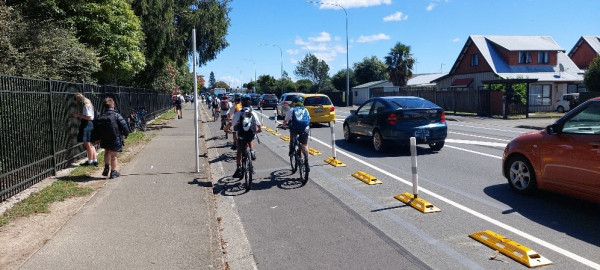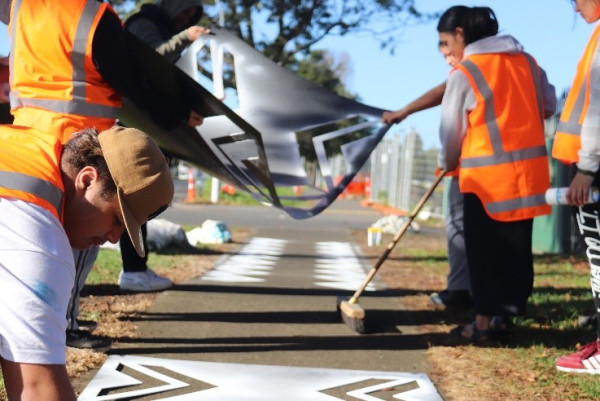Our streets have a vital role to play in creating inclusive, safe, vibrant, and sustainable towns and cities. Ones that are great places to live and where everyone can easily move around using a variety of transport options. The Streets for People programme is supporting councils to partner with their communities to evolve their streets together and create people friendly spaces in a timely and responsive way.
Thirteen councils across Aotearoa are working on 19 projects that will make it safer, easier, and more attractive for people to walk, ride bikes or scooters and take public transport, and to improve road safety and routes to schools.
To achieve this, the councils are using quick, low-cost, scalable improvements that help create more vibrant, people-friendly spaces in their neighbourhoods. This could be through pilots, pop-ups or interim treatments that inform permanent changes planned for the future. This approach to projects is called adaptive urbanism.
These projects will contribute to safer and healthier communities where people have more options in how they travel, and where the transport system contributes to reducing emissions and our resilience to a changing climate.
Councils are working on projects that align with their city or district’s strategic plans. These interim projects allow communities to see what their streets could look like and work through the changes, provide real-time feedback and experience the benefits of more people friendly streets, sooner.
Streets for People projects support the targets in Road to Zero, New Zealand’s Road Safety Strategy and the Emissions Reduction Plan.
Video: Introduction to Streets for People programme 2021–24
Our Streets for People projects
Sign up to receive updates about the Streets for People programme as part of our On the Go newsletter, which provides information about active transport and urban mobility across New Zealand.
Climate change is one of the most significant drivers influencing the land transport system in our lifetime. Not only is transport one of the biggest contributors to overall emissions, but the changing climate is one of the most significant threats to our transport network as extreme weather events and rainfall intensify.
To reduce emissions from the land transport system we need to change the way we do things. Programmes such as Streets for People will give communities travel options to help reduce their reliance on cars while making our cities nicer places to live and our travel healthier and safer.
These changes will help us meet the targets set out in the government’s Emissions Reduction Plan The plan sets out the actions needed across every sector of the economy to reduce emissions, including a specific action to continue with programmes such as Streets for People.
Emissions Reduction Plan (external link)

School children use the trial cycle lane created on Salisbury Street as part of Tasman District Council’s Streets for People project. (Credit: Tasman District Council)
Streets for People is funded by $30m from the National Land Transport Plan. The 13 participating councils are receiving up to 90% of the funding for their projects from the programme with the remaining funding to be provided by the councils themselves.
The programme is being delivered in three phases, and each is a gateway to the next phase:
All councils across Aotearoa with walking and cycling improvements already included in the current Regional Land Transport Plans (RLTPs) were invited to apply to participate in the Streets for People programme. Thirty councils expressed their interest in participating in the programme.
In this phase, Waka Kotahi worked with the councils to build internal capability and ensure organisational readiness, willingness and processes that will enable them to implement projects using adaptive urbanism. Councils also developed an overview of their proposed projects and established project objectives, their approach to community engagement and the processes and resources they would use to support delivery.
In this phase, councils are working alongside their community to design street changes that meet the objectives they set out in Funding the Foundations. These designs are then installed and adapted based on community feedback, informing future permanent changes to the street. Ongoing national support for project planning, design, community engagement, implementation and monitoring and evaluation is being provided by Waka Kotahi.
All projects will be completed by June 2024.

People use stencils to spray paint patterns on a footpath during Auckland Council’s Maximising Māngere Innovating Streets for People project. (Credit: Auckland Council)
The Streets for People programme is built on learnings from Innovating Streets for People which took place from 2019 until 2021. In this programme, councils and community groups across Aotearoa delivered 89km of street changes in 32 towns and cities through adaptive urbanism. These trial changes included cycleways, parklets, low traffic streets, community spaces, and safer school crossings.
Innovating Streets for People 2019–2021
Many of the councils in the Streets for People programme have also received funding from Waka Kotahi to deliver Transport Choices projects.
The projects in Streets for People are designed to do different things than Transport Choices, but with similar outputs. Both programmes are working to make it safer, easier, and more attractive to walk, ride bikes or scooters and take public transport, and are aligned with the Emissions Reduction Plan. Transport Choices is designed to build climate friendly infrastructure quickly, whereas Streets for People is trialling a new way of delivering projects focused on testing and adapting projects based on community feedback.
Waka Kotahi is also leading a programme of work to support the transition to a low emissions transport system in Aotearoa New Zealand. Our vehicle kilometres travelled (VKT) reduction programme is a significant part of this journey. Streets for People provides a testing ground for smaller active travel projects that contribute to a reduction in transport emissions.